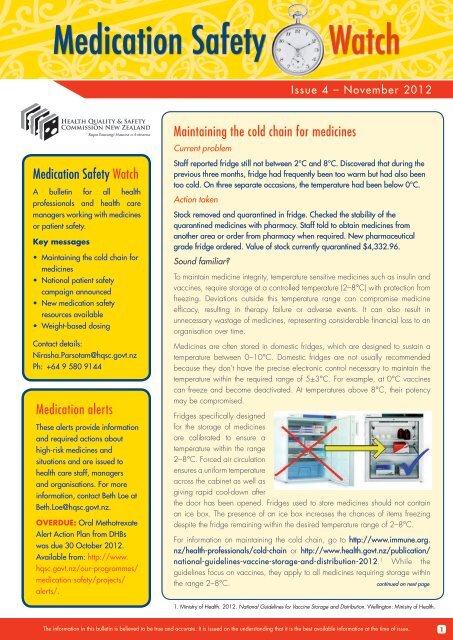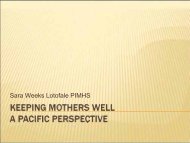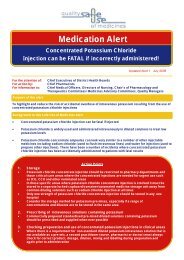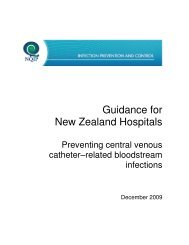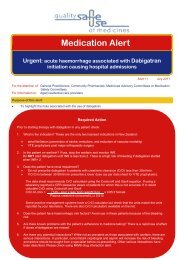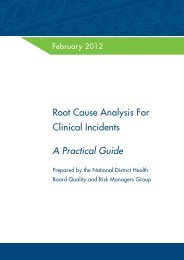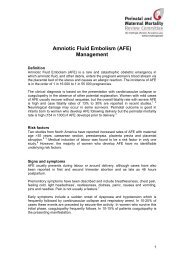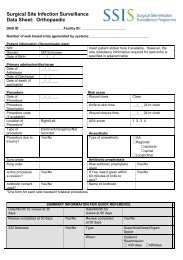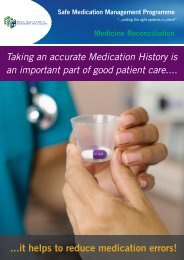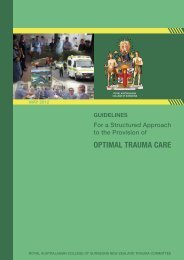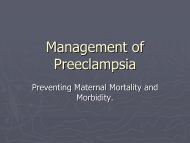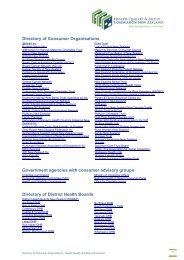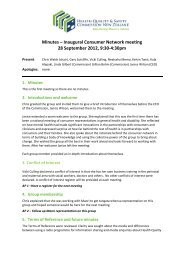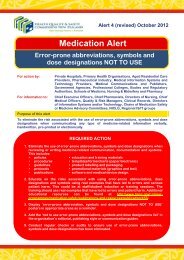Medication Safety Watch - Issue 4, November 2012 - Hqsc.govt.nz
Medication Safety Watch - Issue 4, November 2012 - Hqsc.govt.nz
Medication Safety Watch - Issue 4, November 2012 - Hqsc.govt.nz
You also want an ePaper? Increase the reach of your titles
YUMPU automatically turns print PDFs into web optimized ePapers that Google loves.
<strong>Medication</strong> <strong>Safety</strong><br />
<strong>Watch</strong><br />
<strong>Issue</strong> 4 – <strong>November</strong> <strong>2012</strong><br />
Maintaining the cold chain for medicines<br />
Current problem<br />
<strong>Medication</strong> <strong>Safety</strong> <strong>Watch</strong><br />
A bulletin for all health<br />
professionals and health care<br />
managers working with medicines<br />
or patient safety.<br />
Key messages<br />
• Maintaining the cold chain for<br />
medicines<br />
• National patient safety<br />
campaign announced<br />
• New medication safety<br />
resources available<br />
• Weight-based dosing<br />
Contact details:<br />
Nirasha.Parsotam@hqsc.<strong>govt</strong>.<strong>nz</strong><br />
Ph: +64 9 580 9144<br />
<strong>Medication</strong> alerts<br />
These alerts provide information<br />
and required actions about<br />
high-risk medicines and<br />
situations and are issued to<br />
health care staff, managers<br />
and organisations. For more<br />
information, contact Beth Loe at<br />
Beth.Loe@hqsc.<strong>govt</strong>.<strong>nz</strong>.<br />
OVERDUE: Oral Methotrexate<br />
Alert Action Plan from DHBs<br />
was due 30 October <strong>2012</strong>.<br />
Available from: http://www.<br />
hqsc.<strong>govt</strong>.<strong>nz</strong>/our-programmes/<br />
medication-safety/projects/<br />
alerts/.<br />
Staff reported fridge still not between 2°C and 8°C. Discovered that during the<br />
previous three months, fridge had frequently been too warm but had also been<br />
too cold. On three separate occasions, the temperature had been below 0°C.<br />
Action taken<br />
Stock removed and quarantined in fridge. Checked the stability of the<br />
quarantined medicines with pharmacy. Staff told to obtain medicines from<br />
another area or order from pharmacy when required. New pharmaceutical<br />
grade fridge ordered. Value of stock currently quarantined $4,332.96.<br />
Sound familiar<br />
To maintain medicine integrity, temperature sensitive medicines such as insulin and<br />
vaccines, require storage at a controlled temperature (2–8°C) with protection from<br />
freezing. Deviations outside this temperature range can compromise medicine<br />
efficacy, resulting in therapy failure or adverse events. It can also result in<br />
unnecessary wastage of medicines, representing considerable financial loss to an<br />
organisation over time.<br />
Medicines are often stored in domestic fridges, which are designed to sustain a<br />
temperature between 0–10°C. Domestic fridges are not usually recommended<br />
because they don’t have the precise electronic control necessary to maintain the<br />
temperature within the required range of 5±3°C. For example, at 0°C vaccines<br />
can freeze and become deactivated. At temperatures above 8°C, their potency<br />
may be compromised.<br />
Fridges specifically designed<br />
for the storage of medicines<br />
are calibrated to ensure a<br />
temperature within the range<br />
2–8°C. Forced air circulation<br />
ensures a uniform temperature<br />
across the cabinet as well as<br />
giving rapid cool-down after<br />
the door has been opened. Fridges used to store medicines should not contain<br />
an ice box. The presence of an ice box increases the chances of items freezing<br />
despite the fridge remaining within the desired temperature range of 2–8°C.<br />
For information on maintaining the cold chain, go to http://www.immune.org.<br />
<strong>nz</strong>/health-professionals/cold-chain or http://www.health.<strong>govt</strong>.<strong>nz</strong>/publication/<br />
national-guidelines-vaccine-storage-and-distribution-<strong>2012</strong>. 1 While the<br />
guidelines focus on vaccines, they apply to all medicines requiring storage within<br />
the range 2–8°C.<br />
continued on next page<br />
1. Ministry of Health. <strong>2012</strong>. National Guidelines for Vaccine Storage and Distribution. Wellington: Ministry of Health.<br />
The information in this bulletin is believed to be true and accurate. It is issued on the understanding that it is the best available information at the time of issue.<br />
1
<strong>Medication</strong> <strong>Safety</strong> <strong>Watch</strong><br />
continued from page 1<br />
<strong>Medication</strong> safety tips<br />
1. Designate someone to be responsible for the medicine fridge or add it to a<br />
checklist that a manager sees daily.<br />
2. Minimise the stock kept in medicine fridges.<br />
3. Ensure medicine fridges are permanently wired in place to prevent accidental<br />
disconnection and are on essential power supply in case of power failure.<br />
4. Leave medicines in their original packaging and ensure there is adequate<br />
airflow around the medicines stored in the fridge.<br />
5. Review temperature charts daily and act immediately when an out-of-range<br />
temperature is detected.<br />
6. Tell your patients to store their medicines in the middle of their fridge at home,<br />
not in the door or back of the fridge.<br />
What’s new<br />
National patient safety campaign<br />
The goal is safe, quality health care –<br />
every day, every time. The Health Quality<br />
& <strong>Safety</strong> Commission will work with the<br />
sector to reduce harm in these four areas;<br />
falls, medication errors, surgery and<br />
health care associated infections. Initially,<br />
the focus will be on proven improvements<br />
in the hospital setting that complement<br />
providers’ existing quality and safety<br />
strategies. For more information, see<br />
http://www.hqsc.<strong>govt</strong>.<strong>nz</strong>/nationalpatient-safety-campaign/.<br />
SafeRx is an initiative by the Quality Use<br />
of Medicines (QUM) Team at Waitemata<br />
District Health Board. The website,<br />
www.saferx.co.<strong>nz</strong>, contains resource<br />
materials designed for health professionals<br />
working in primary care to promote the safe<br />
and effective use of high-risk medicines.<br />
New medication safety resources<br />
Incidents and cautions<br />
Paracetamol toxicity<br />
A community patient was receiving her<br />
‘when required’ paracetamol tablets<br />
via a blister pack supported by a home<br />
support worker. The patient unintentionally<br />
overdosed on the tablets left with her to<br />
self-administer. She suffered hepatic and<br />
renal failure and died after eight days in<br />
hospital. Consider limiting the supply of<br />
‘when required’ medicines that are left<br />
with a patient for self-administration to<br />
24 hours worth.<br />
Look and sound alike generic<br />
medicines<br />
The Commission continues to receive<br />
reports of look-alike generic medicines<br />
(see images below) and is pursuing these<br />
with the stakeholders involved. Minimise<br />
the risk of an error by storing such<br />
identified medicines out of order or in an<br />
alternate location.<br />
Weight-based dosing<br />
When the dose of a medicine is<br />
dependent on the patient’s weight (eg,<br />
with enoxaparin), you need to check the<br />
weight you use is accurate and current.<br />
Estimation is risky and can result in patient<br />
harm. Document the weight used for<br />
dosing on the order or prescription so<br />
the dose can be checked by others.<br />
Upcoming events<br />
• 5th International <strong>Medication</strong><br />
<strong>Safety</strong> Network <strong>Medication</strong> <strong>Safety</strong><br />
Conference, 15–17 <strong>November</strong><br />
<strong>2012</strong> Abu Dhabi, UAE http://www.<br />
medicationsafetyconference.com/<br />
index.aspx<br />
Ask a pharmacist before you<br />
crush or split oral dose forms.<br />
Crushing, chewing, cutting or<br />
diluting certain oral medicines<br />
may destroy the intended effect<br />
of the medicine and may cause<br />
an adverse event.<br />
Contribute to <strong>Medication</strong><br />
<strong>Safety</strong> <strong>Watch</strong><br />
Are you or your organisation<br />
working on a new medication<br />
safety initiative Has there been a<br />
medicine-related incident or error<br />
that has happened that you would<br />
like to warn others about If so,<br />
please contact:<br />
Nirasha.Parsotam@hqsc.<strong>govt</strong>.<strong>nz</strong><br />
Check out the Commission link http://<br />
www.hqsc.<strong>govt</strong>.<strong>nz</strong>/our-programmes/<br />
medication-safety for new medication<br />
safety resources, including Version 3 of the<br />
Standards and two short New Zealand<br />
videos featuring hospital staff on medicine<br />
reconciliation and the medication chart.<br />
www.hqsc.<strong>govt</strong>.<strong>nz</strong><br />
The information in this bulletin is believed to be true and accurate. It is issued on the understanding that it is the best available information at the time of issue. 2


